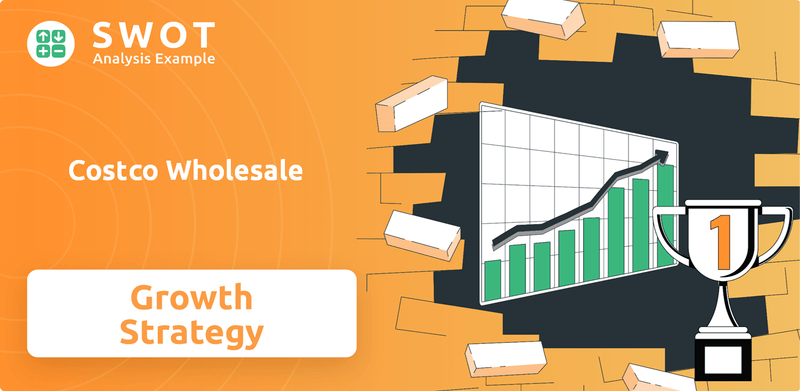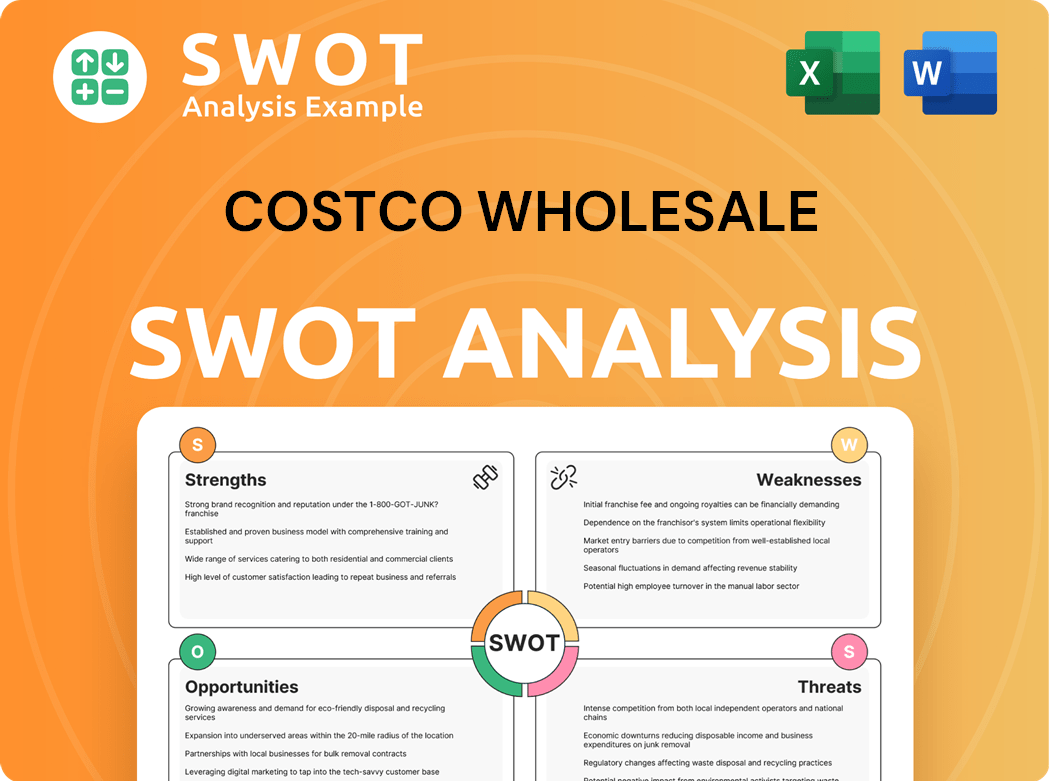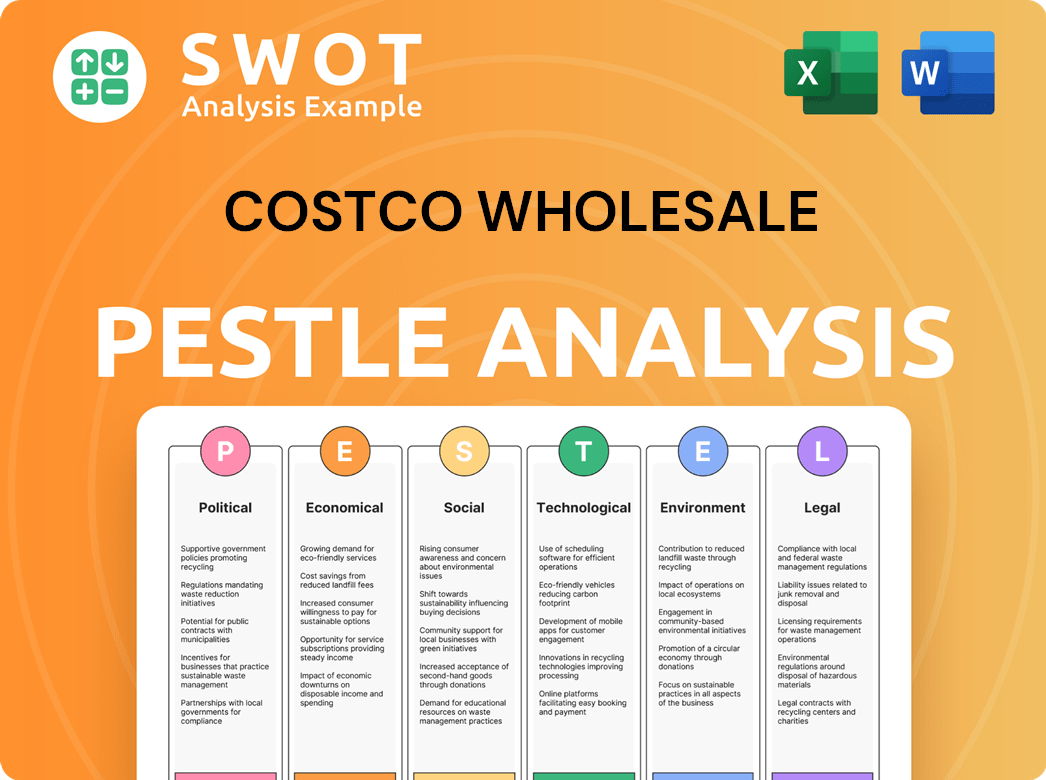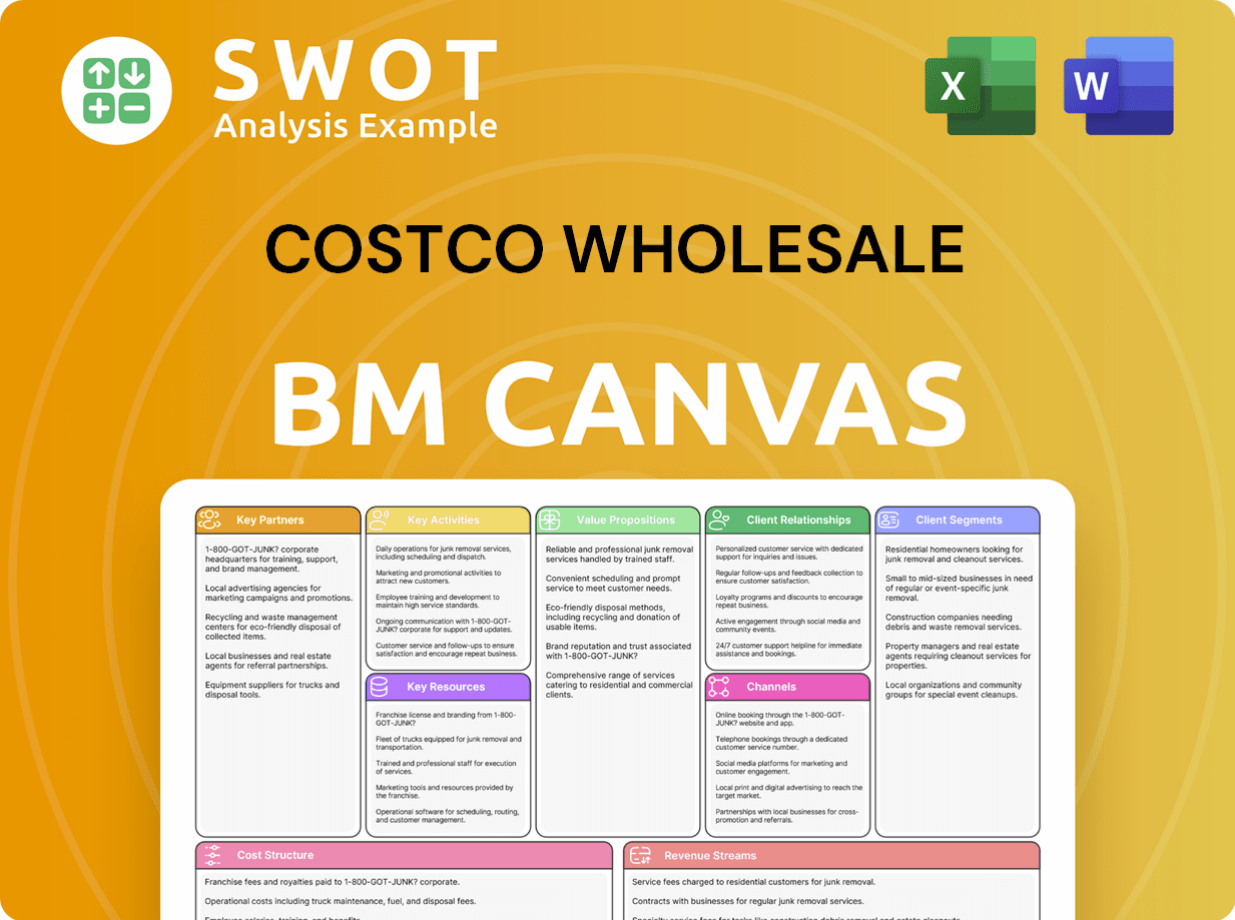Costco Wholesale Bundle
Can Costco Maintain Its Retail Dominance?
Costco Wholesale Corporation, a retail giant since 1983, has redefined the shopping experience with its membership-only warehouse club model. From its humble beginnings in Seattle, Costco has become a global powerhouse, currently the fifth-largest retailer worldwide. But what's the Costco Wholesale SWOT Analysis behind this remarkable success, and what does the future hold for this retail innovator?

This exploration delves into the Costco growth strategy, examining its expansion plans and innovative approaches to maintain its competitive edge. We'll analyze Costco's future prospects, including its financial performance and strategies for sustainable growth within the warehouse club industry. Understanding Costco's business model, its impact on local economies, and its long-term investment potential is key to appreciating its continued success in a dynamic market.
How Is Costco Wholesale Expanding Its Reach?
The Costco growth strategy centers on aggressive expansion, targeting both domestic and international markets to fuel its Costco future prospects. This strategy is a key component of the Costco wholesale company's long-term vision, aiming to increase its global footprint and market share. The expansion plans are supported by a strong Costco business model that prioritizes membership fees and high sales volumes.
The company's expansion strategy includes opening new warehouses and strategically entering high-growth markets. These moves are designed to boost market penetration, increase sales, and mitigate risks associated with economic fluctuations. The focus on both physical and digital retail channels is also crucial for sustained growth. You can learn more about the company's ownership in the article: Owners & Shareholders of Costco Wholesale.
Costco's expansion strategy is a key driver of its financial performance, with new warehouse openings and international growth contributing significantly to revenue and membership growth. The company's ability to adapt to changing consumer preferences and market dynamics will be critical for its continued success.
Costco plans to open 29 new warehouses during fiscal year 2025 (September 2024 through August 2025). This includes 26 net new locations and 3 relocations. The company aims to have 914 warehouses globally by the end of fiscal 2025, up from 890 in 2024.
Of the new warehouses, 10 will be outside the U.S. Key international locations include Minami Alps in Japan (April 2025), Ardeer in Australia (later in 2025), Pyeongtaek, South Korea (June 2025), and Malmö, Sweden (July 2025).
Costco is pushing into high-growth markets like Texas to increase market penetration and sales. Geographic diversification helps reduce risks from regional economic slowdowns. The company sees significant growth opportunities in Canada, Mexico, Europe, and Asia.
A new 140,000 square meter (1.5 million square feet) fulfillment center in Torija, Spain, is Costco's first logistics center in Europe, indicating its ambitions in the region. This center will support the company's growing European operations.
The expansion includes specific locations opening in March and April 2025, as well as later in the year. These new warehouses are strategically placed to capture market share and serve growing consumer bases.
- Brentwood, California
- Highland, California
- Prosper, Texas
- Weatherford, Texas
- Genesee County, Michigan
- Sharon, Massachusetts
- Stuart, Florida
- Minami Alps, Japan
- Ardeer, Australia
- Pyeongtaek, South Korea
- Malmö, Sweden
- Midland, Texas
Costco Wholesale SWOT Analysis
- Complete SWOT Breakdown
- Fully Customizable
- Editable in Excel & Word
- Professional Formatting
- Investor-Ready Format

How Does Costco Wholesale Invest in Innovation?
The shift towards technology and innovation is a key element of the Costco growth strategy, indicating a move away from its traditional methods. This strategic pivot, guided by new leadership, is focused on enhancing both its technological infrastructure and the services it offers to customers.
The company's focus on innovation is evident in its efforts to boost e-commerce capabilities and operational efficiencies. This includes streamlining member transactions and adopting sustainable practices. These initiatives are crucial for Costco's future prospects and maintaining its competitive edge in the market.
Costco wholesale company is adapting to meet evolving consumer demands by integrating technology and improving its digital presence. These changes are aimed at providing a better shopping experience and driving sustained growth.
Digital sales are a significant growth area for Costco. In the quarter ending May 12, 2024, online sales increased by over 20% compared to the previous year. This growth is driven by investments in digital transformation.
In fiscal year 2024, online sales rose by 16.1%, contributing to a 5.3% increase in overall sales. E-commerce comparable sales saw a substantial increase of 14.8% in Q3 of fiscal year 2025.
Costco is piloting a 'buy online, pick up in-store' program. This initiative is starting with electronics and is planned to expand to include more products. This strategy enhances convenience for members.
The company has expanded its partnership with Uber Technologies for deliveries. This service is available in 17 U.S. states and Canada, with plans for international expansion. This enhances its Costco expansion plans.
In Q1 of fiscal year 2025, e-commerce sales increased by 13%, site traffic grew by 16%, and the average order value rose by 4%. Mobile application downloads surged by 29%, and Costco Logistics deliveries increased by 17% in fiscal 2024.
While R&D expenses are not significant, the company focuses on operational efficiencies and digital transformation. This includes using RFID technology for inventory tracking and data analytics for demand forecasting. The company also focuses on sustainable business practices.
Costco's innovation strategy centers on enhancing e-commerce, improving operational efficiency, and embracing sustainable practices. These efforts are designed to improve the customer experience and boost profitability. For more insights, you can explore the Competitors Landscape of Costco Wholesale.
- Expanding e-commerce capabilities to meet growing online demand.
- Implementing RFID technology for improved inventory management.
- Utilizing data analytics to forecast demand and optimize supply chains.
- Enhancing self-checkout systems to streamline member transactions.
- Focusing on sustainable sourcing and waste reduction to support Costco sustainable business practices.
Costco Wholesale PESTLE Analysis
- Covers All 6 PESTLE Categories
- No Research Needed – Save Hours of Work
- Built by Experts, Trusted by Consultants
- Instant Download, Ready to Use
- 100% Editable, Fully Customizable

What Is Costco Wholesale’s Growth Forecast?
The financial outlook for the company indicates sustained growth and strategic expansion. The company's performance in April 2025 showed strong sales figures, reflecting its robust business model. This financial success is supported by increasing membership and high renewal rates, which are key components of the company's strategy.
The company's financial performance is driven by a combination of strong sales growth, effective cost management, and a loyal customer base. The company's emphasis on value and customer satisfaction contributes to its financial health. This approach has positioned the company favorably within the warehouse club industry, setting it up for continued growth.
The company's growth strategy focuses on expanding its physical presence and increasing its online sales. This dual approach allows the company to reach a wider customer base and capitalize on evolving consumer preferences. The company's commitment to providing value and a positive shopping experience supports its long-term growth prospects.
In April 2025, net sales reached $21.18 billion, a 7.0% increase year-over-year. For the first 35 weeks of the fiscal year, net sales were $180.05 billion, an 8.2% increase compared to the same period last year. Comparable sales for April 2025 increased by 5.2% in the U.S.
E-commerce sales saw a significant rise, with a 12.6% increase in April 2025. In Q3 fiscal year 2025, e-commerce comparable sales grew by 14.8%. This indicates the company's success in adapting to online retail trends and expanding its digital footprint.
The net profit margin for the quarter ending February 28, 2025, was 2.89%. The average net profit margin for 2024 was 2.85%, a 9.62% increase from 2023. Gross margin for the quarter ending February 28, 2025, was 12.67%, and the average gross margin for 2024 was 12.54%, a 2.79% increase from 2023.
Membership fees are a crucial revenue stream. In fiscal year 2023, membership fees contributed about $4.5 billion. The company expects a 15% increase in membership income in the first year of fiscal 2025 due to a membership fee hike, and a 7% increase each year after that, reaching $7.2 billion. Renewal rates remained high at 90.2% in Q3 fiscal 2025.
Analysts project average earnings per share (EPS) of $3.81 for Q1 2025, $4.18 for Q2 2025, $4.24 for Q3 2025, and $5.73 for Q4 2025. The average EPS estimate for the full fiscal year 2025 is $17.96. The company's stock is generally rated as a 'Moderate Buy,' with an average twelve-month stock price forecast of $1,035.32.
- These projections reflect confidence in the company's continued financial health.
- The positive outlook is supported by strong sales growth and effective cost management.
- High membership renewal rates and expansion plans further contribute to the positive forecast.
- For more details, read about the Revenue Streams & Business Model of Costco Wholesale.
Costco Wholesale Business Model Canvas
- Complete 9-Block Business Model Canvas
- Effortlessly Communicate Your Business Strategy
- Investor-Ready BMC Format
- 100% Editable and Customizable
- Clear and Structured Layout

What Risks Could Slow Costco Wholesale’s Growth?
The path for Costco Wholesale is not without its challenges. The company faces several risks that could affect its growth, from economic pressures to increased competition. These factors require careful management to maintain its success.
One of the main concerns is the impact of economic factors like inflation and supply chain disruptions. Rising costs can squeeze profit margins if the company cannot adjust its pricing effectively. Supply chain issues, such as natural disasters or trade tensions, can also disrupt operations and impact the ability to offer low prices, a core part of the Costco business model.
The retail industry is highly competitive, with companies like Amazon and other warehouse clubs vying for market share. This competition means Costco must continually differentiate itself to maintain customer loyalty. The company's commitment to low prices, while a strength, also means it operates on thin margins, which can be vulnerable to rising costs.
Inflation and supply chain issues can significantly affect Costco's financial performance. Rising costs can erode profit margins if not managed effectively. For example, fluctuating tariffs from U.S.-China trade tensions directly impact costs and pricing.
The retail landscape is intensely competitive, with rivals focusing on omnichannel strategies. Other warehouse clubs are also growing, making differentiation crucial for Costco. The company's low-margin business model is challenged by rising costs.
Costco's expansion plans into international markets bring risks like cultural differences and regulatory pressures. The bulk product model might not suit all regions due to population density and shopping habits. Changes in trade policies can also lead to higher prices.
Technological advancements and the need for digital transformation present challenges for Costco. The company's e-commerce investments have historically lagged behind competitors. Limited R&D spending could affect its ability to adapt to changing customer preferences.
Internal resource constraints, such as rising labor costs, could impact Costco's ability to maintain low prices and its competitive edge. Increased scrutiny of membership policies, including verification systems and food court access, adds to operational challenges.
The evolving legal and regulatory environment, including Diversity, Equity, and Inclusion (DEI) initiatives, presents additional challenges. Compliance with these regulations requires ongoing adjustments to business practices and policies.
Thin margins, around 11% in recent years, make Costco vulnerable to rising costs. Increased labor costs and supply chain issues can squeeze these margins further. The company needs to balance maintaining low prices with profitability.
Tightened membership verification and food court access policies, as of April 2024, reflect efforts to manage unauthorized use. These changes, along with internal resource constraints, impact operations and customer experience. Increased scrutiny requires careful management.
Costco Wholesale Porter's Five Forces Analysis
- Covers All 5 Competitive Forces in Detail
- Structured for Consultants, Students, and Founders
- 100% Editable in Microsoft Word & Excel
- Instant Digital Download – Use Immediately
- Compatible with Mac & PC – Fully Unlocked

Related Blogs
- What are Mission Vision & Core Values of Costco Wholesale Company?
- What is Competitive Landscape of Costco Wholesale Company?
- How Does Costco Wholesale Company Work?
- What is Sales and Marketing Strategy of Costco Wholesale Company?
- What is Brief History of Costco Wholesale Company?
- Who Owns Costco Wholesale Company?
- What is Customer Demographics and Target Market of Costco Wholesale Company?
Disclaimer
All information, articles, and product details provided on this website are for general informational and educational purposes only. We do not claim any ownership over, nor do we intend to infringe upon, any trademarks, copyrights, logos, brand names, or other intellectual property mentioned or depicted on this site. Such intellectual property remains the property of its respective owners, and any references here are made solely for identification or informational purposes, without implying any affiliation, endorsement, or partnership.
We make no representations or warranties, express or implied, regarding the accuracy, completeness, or suitability of any content or products presented. Nothing on this website should be construed as legal, tax, investment, financial, medical, or other professional advice. In addition, no part of this site—including articles or product references—constitutes a solicitation, recommendation, endorsement, advertisement, or offer to buy or sell any securities, franchises, or other financial instruments, particularly in jurisdictions where such activity would be unlawful.
All content is of a general nature and may not address the specific circumstances of any individual or entity. It is not a substitute for professional advice or services. Any actions you take based on the information provided here are strictly at your own risk. You accept full responsibility for any decisions or outcomes arising from your use of this website and agree to release us from any liability in connection with your use of, or reliance upon, the content or products found herein.